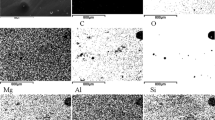Abstract
Libyan Desert Glasses (LDGs) and Darwin Glasses (DGs) are impact glasses produced by the impact of an extraterrestrial body into the Earth million years ago. LDGs were formed in the Libyan Desert (Africa) and DGs in Tasmania (Australia). From their formation, they have suffered terrestrial weathering processes due to their interaction with the environment. This is the first work that has evaluated their weathering processes according to their composition, the surrounding environment, and the climate. An innovative methodology based on the leaching of organic and inorganic ions and chemical modeling simulations was employed. Inductively coupled plasma-mass spectrometry (ICP-MS), ionic chromatography (IC), and solid-phase microextraction (SPME), and head space (HS) injections coupled to gas chromatography and mass spectrometry (GC-MS) detection were used. As a result, soluble organic compounds such as oxalates, n-hexadecanoic acid, and 4-chlorobenzalacetone were detected. The inorganic ions suffered a similar process, going inside the body of glasses and precipitating the corresponding salts when water evaporated. As these compounds are polar, they were probably transported by infiltration waters from outside the glasses, remaining inside in the pores, cavities, or cracks of the glasses during thousands of years. In the case of the DGs, it could be observed that under the oxidizing conditions of the terrestrial atmosphere, sulfides present in some samples transformed into sulfates. Finally, this methodology could be applied in other extraterrestrial materials discovered in deserts, ice fields, or in locations with great living activity like those of Tasmania.







Similar content being viewed by others
References
Bennett CJ, Pirim C, Orlando TM. Space-weathering of solar system bodies: a laboratory perspective. Chem Rev. 2013;113:9086–150.
Bland PA, Zolensky ME, Benedix GK, Sephton MA. Weathering of chondritic meteorites. In: Meteorites and the early solar system II. Lauretta DS, McSween HY, editors. The University of Arizona Press. USA; 2006. pp. 853-867.
Crozaz G, Wadhwa M. The terrestrial alteration of Saharan Shergottites Dar al Gani 476 and 489: a case study of weathering in a hot desert environment. Geochim Cosmochim Ac. 2001;65:971–8.
Hamann C, Hecht L, Ebert M, Wirth R. Chemical projectile–target interaction and liquid immiscibility in impact glass from the Wabar craters, Saudi Arabia. Geochim Cosmochim Ac. 2013;121:291–310.
Thackrey S, Walkden G, Indares A, Horstwood M, Kelley S, Parrish R. The use of heavy mineral correlation for determining the source of impact ejecta: a Manicouagan distal ejecta case study. Earth Planet Sci Lett. 2009;285:163–72.
Gómez-Nubla L, Aramendia J, Fdez-Ortiz de Vallejuelo S, Castro K, Madariaga JM. Detection of organic compounds in impact glasses formed by the collision of an extraterrestrial material with the Libyan Desert (Africa) and Tasmania (Australia). Anal Bioanal Chem. 2018;25:6609–17.
Storzer D, Wagner GA. Fission-track dating of meteorite impacts. Meteoritics. 1977;12:368–9.
Howard KT. Physical distribution trends in Darwin glass. Meteorit Planetary Sci. 2009;44:115–29.
Aboud T. Libyan Desert Glass: has the enigma of its origin been resolved? Phys Procedia. 2009;2:1425–32.
White JS, Henderson EP, Mason B. Secondary minerals produced by weathering of the wolf creek meteorite. Am Min. 1967;52:1190–7.
Gómez-Nubla L, Aramendia J, Fdez-Ortiz de Vallejuelo S, Alonso-Olazabal A, Castro K, Zuluaga MC, et al. Multispectroscopic methodology to study Libyan Desert Glass and its formation conditions. Anal Bioanal Chem. 2017;409:3597–610.
Gómez-Nubla L, Aramendia J, Alonso-Olazabal A, Fdez-Ortiz de Vallejuelo S, Castro K, Ortega LA, et al. Darwin impact glass study by Raman spectroscopy in combination with other spectroscopic techniques. J Raman Spectrosc. 2015;46:913–9.
Gómez-Nubla L, Aramendia J, Fdez-Ortiz de Vallejuelo S, Carrero JA. Madariaga JM. Focused ultrasound energy over steel slags as a fast tool to assess their environmental risk before and after their reuse in agriculture and civil constructions. Microchem J. 2017;132:268–73.
Papangelakis VG, Moldoveanu G. Recovery of rare earth elements from clay minerals. ERES2014: 1st European Rare Earth Resources Conference Milos 04-07/09/2014.
Martinez-Ruiz F, Ortega-Huertas M, Rivas P. Rare earth element composition as evidence of the precursor material of Cretaceous –Tertiary boundary sediments at distal sections. Chem Geol. 2006;232:1–11.
Puigdomenech I. MEDUSA (Make Equilibrium Diagrams Using Sophisticated Algorithms), v-15. Stockholm, Sweden: Department of Inorganic Chemistry, The Royal Institute of Technology; 2012.
ChemIDplus. U.S. National Libray of Medicine. A TOXNET DATABASE (http://chem.sis.nlm.nih.gov/chemidplus/).
Howard KT, Bailey MJ, Berhanu D, Bland PA, Cressey G, Howard LE, et al. Biomass preservation in impact melt ejecta. Nat Geosci. 2013;6:1018–22.
Howard KT. Geochemistry of Darwin glass and target rocks from Darwin crater, Tasmania. Australia. Meteorit Planet Sci. 2008;43:479–96.
Parsons AJ, Abrahams AD. Geomorphology of Desert Environments. 2nd ed. Springer; 2009.
Acknowledgements
Technical and human support provided by SCAB from SGIker of UPV/EHU (UPV/EHU, MINECO, GV/EJ, ERDF, and ESF (SGIker)) is gratefully acknowledged.
Funding
This work has been supported by the Exomars-Raman project (ref. ESP2017-87690-C3-1-R), funded by the Spanish Agency for Research AEI (MINECO-FEDER/UE).
Author information
Authors and Affiliations
Corresponding author
Ethics declarations
Conflict of interest
The authors declare that they have no conflict of interest.
Additional information
Publisher’s note
Springer Nature remains neutral with regard to jurisdictional claims in published maps and institutional affiliations.
Electronic supplementary material
ESM 1
(PDF 181 kb)
Rights and permissions
About this article
Cite this article
Gómez-Nubla, L., Aramendia, J., Fdez-Ortiz de Vallejuelo, S. et al. Analytical methodology to evaluate the Terrestrial Weathering of Libyan Desert Glasses and Darwin Glasses after their formation. Anal Bioanal Chem 411, 7869–7877 (2019). https://doi.org/10.1007/s00216-019-02191-5
Received:
Revised:
Accepted:
Published:
Issue Date:
DOI: https://doi.org/10.1007/s00216-019-02191-5




